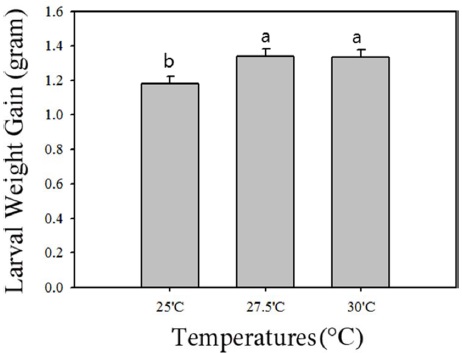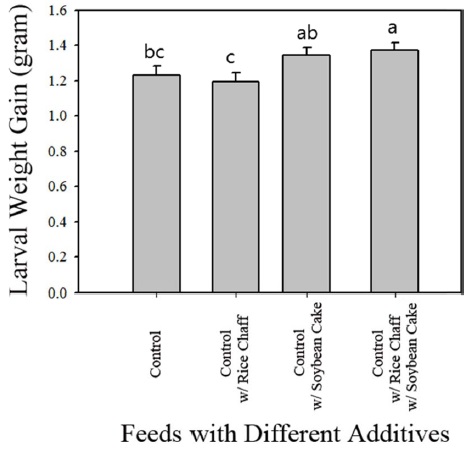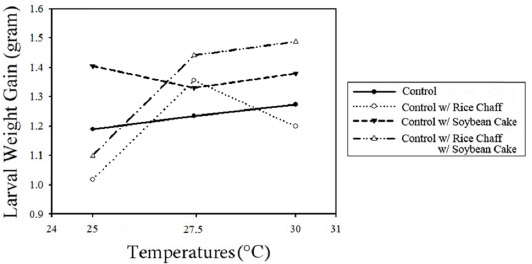



The white-spotted chafer, Protaetia brevitarsis (Coleoptera: Scarabaeidae), is an economically important insect in Korea. Traditionally, it has been regarded as a medicine for preventing liver-related diseases and suppressing liver cancer. Recently, this beetle was enlisted as a temporal food ingredient by Korean Ministry of Food and Drug Safety. Therefore, this beetle is focused as a one of the important insects that are commercially reared and sold in Korea. As the economic importance of this beetle is growing, the suitable rearing conditions are needed for more detailed investigation. In this study, we compared three temperature conditions and two food additives, rice chaff and soybean cake, for its effects on the body weight change of third instar larvae of P. brevitarsis. Temperature is a major environmental factor that has tremendous effects on rearing insects. In additions, rice chaff and soybean cake are byproducts of other agricultural activities. Therefore, it is easy to get, and the price is comparatively low. However, they still have meaningful amount of nutrients. With four different kinds of feed and three temperature conditions on the third instar larvae of beetles, the body weight change was tracked for 14 wk. We concluded that 27.5℃ is the optimal temperature to rear the third instar larvae among three temperatures (25, 27.5, and 30℃). Among four different feeds, conventional fermented oak saw dust with rice chaff and soybean cake was the best feed for larval weight gain during 14 wk. However, feed with soybean cake at 30 ℃ was the best condition for rearing P. brevitarsis larvae when temperatures and feeds were compared at the same time.
The third instar larvae of
>
Feeds with Different Additives
The basic feed was fermented oak sawdust that was mixed with 60% of oak sawdust, 30% of wheat bran, and 10% of previous fermented oak sawdust to provide useful microbes that help fermentation. To test the effects of feed additives, we added rice chaff and/or soybean cake based on the Table 1. The rice chaff and soybean cake were mixed with fermented oak sawdust. After mixing it, the feed were fermented for one more month.
[Table 1.] Composition of four different feeds with two feed additives ? rice chaff and soybean cake
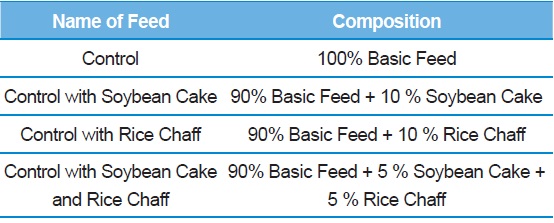
Composition of four different feeds with two feed additives ? rice chaff and soybean cake
>
Rearing Condition and Experimental Design
The third instar larva was reared in a round petri dish (98 mm diameter X 15 mm depth) with enough designated feed. The rearing room was set as 25, 27.5 and 30℃ with ca. 40% humidity and 12:12(L:D) light condition. We measured body weight and state of each larva, and changed feed once per a week. For each treatment, 10 individuals for the third instar larvae were maintained for 14 wk. It was enough time for the most of second instar larvae to pupate. Three replications for each treatment were conducted. Each of three biological replications, independent batches of different feeds and temperatures, consisted of ten technical replications. A technical replication was a set of 12 different treatments ( four feeds X three temperatures). Averages and standard deviations of weight increase for each week, accumulated weight increase, and weight before pupation were calculated and compared each feed treatment to control feed with t-test and ANOVA analysis.
Larval weight gain was significantly different by rearing temperatures (d
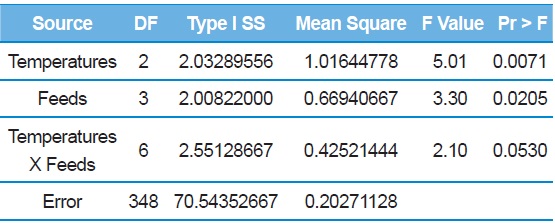
Results for ANOVA test with three temperatures and four feeds. Ten P. brevitarsis larvae per each treatment with three replication were analyzed for their larval weight gain for 14 wk
As analyzing the effects of different feed additives, a feed with soybean cake and rice chaff showing the best effect on the larval weight gain (Fig. 2). However, the difference between the feed with soybean cake and rice chaff and the feed with soybean cake was not significantly different. However, the feed with rice chaff showed the least larval weight gain during 14-wk experiment. Even though the difference was not significant, adding rice chaff did not show meaningful effects on larval weight gain. The effects of different composition of feed on the larval weight gain of
When the interaction between rearing temperatures and different feed additives analyzed, the larval weight with control feed and feed with soybean cake was increased as the temperature increased from 25 to 30℃ (Fig. 3). In addition, the larval weight with soybean cake and rice chaff at 27.5℃ was lower than other two temperature condition, 25 and 30℃. Interestingly, the larval weight gain with rice chaff at 30℃ compared to 27.5℃. These results showed that the larval weight gain is different by temperature as well as the feed additives.
With four different feeds and three temperature conditions, we concluded that larvae reared with soybean cake at 30℃ showed the best result for the larval weight gain. However, the difference between the larval weight gain with soybean cake at 27.5 and at 30℃ was not significant, but it requires lots of resources to keep 30℃. Therefore, we concluded that it is the best to rear

